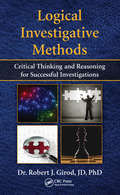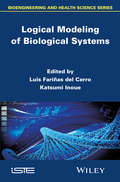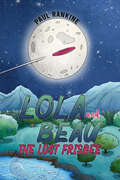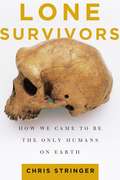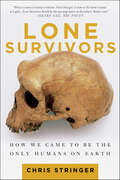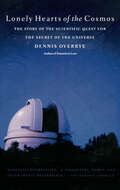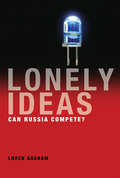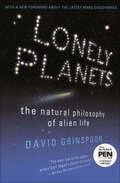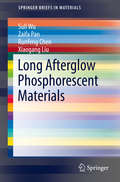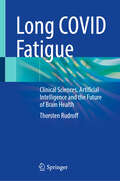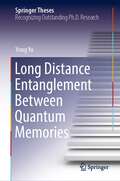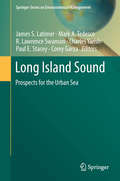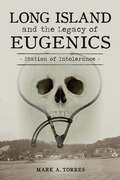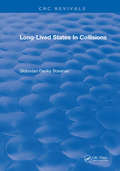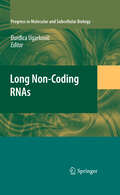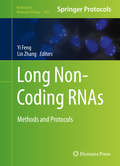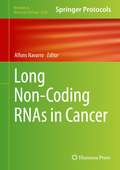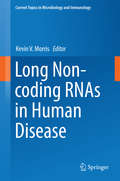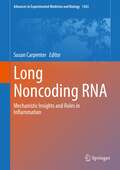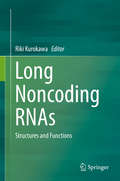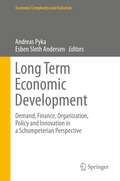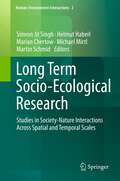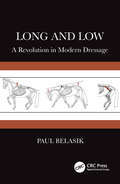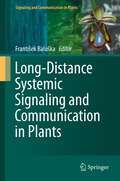- Table View
- List View
Logical Investigative Methods: Critical Thinking and Reasoning for Successful Investigations
by Robert J. GirodThis book describes how to use logic, reasoning, critical thinking, and the scientific method to conduct and improve criminal and civil investigations. The author discusses how investigators and attorneys can avoid assumptions and false premises and instead make valid deductions, inductions, and inferences. He explains how tools such as interview and interrogation can be used to detect deception and profile unknown individuals and suspects. The book is aimed at improving not only the conduct of investigations, but also the logical use of cognitive, analytical, documentation, and presentation tools to win cases.
Logical Modeling of Biological Systems
by Katsumi Inoue Luis Fariñas del CerroSystems Biology is the systematic study of the interactions between the components of a biological system and studies how these interactions give rise to the function and behavior of the living system. Through this, a life process is to be understood as a whole system rather than the collection of the parts considered separately. Systems Biology is therefore more than just an emerging field: it represents a new way of thinking about biology with a dramatic impact on the way that research is performed. The logical approach provides an intuitive method to provide explanations based on an expressive relational language. This book covers various aspects of logical modeling of biological systems, bringing together 10 recent logic-based approaches to Systems Biology by leading scientists. The chapters cover the biological fields of gene regulatory networks, signaling networks, metabolic pathways, molecular interaction and network dynamics, and show logical methods for these domains based on propositional and first-order logic, logic programming, answer set programming, temporal logic, Boolean networks, Petri nets, process hitting, and abductive and inductive logic programming. It provides an excellent guide for all scientists, biologists, bioinformaticians, and engineers, who are interested in logic-based modeling of biological systems, and the authors hope that new scientists will be encouraged to join this exciting scientific endeavor.
Logischer Empirismus, Lebensreform und die deutsche Jugendbewegung: Logical Empiricism, Life Reform, and the German Youth Movement (Veröffentlichungen des Instituts Wiener Kreis #32)
by Christian Damböck Günther Sandner Meike G. WernerThis open-access book is the first to investigate the roots of Logical Empiricism in the context of the Life Reform and the German Youth Movements. Rudolf Carnap and Hans Reichenbach are the key protagonists; they both belonged to the German Youth Movement and developed their early philosophical views in this setting. By combining scholarly essays with unpublished and hard to access manuscripts, letters, and articles, this volume recasts our understanding of the early years of Logical Empiricism.
Lola and Beau - The Lost Frisbee
by Paul RankineFlying saucers, colourful planets, shining stars and erm... a playful game of hide and seek with aliens? Not your usual day at the park! But one that Lola and her trusty pooch Beau won’t forget in a hurry! An intergalactic adventure for all to enjoy.
Lone Survivors: How We Came to Be the Only Humans on Earth
by Chris StringerIn this groundbreaking and engaging work, world-renowned paleoanthropologist Stringer sets out a new theory of humanity's origin, offering the definitive account of who and what we were, and a work that will change perceptions about our origins and about what it means to be human.
Lone Survivors: How We Came to Be the Only Humans on Earth
by Chris StringerA top researcher proposes a controversial new theory of human evolution in a book “combining the thrill of a novel with a remarkable depth of perspective” (Nature).In this groundbreaking and engaging work of science, world-renowned paleoanthropologist Chris Stringer sets out a new theory of humanity’s origin, challenging both the multiregionalists (who hold that modern humans developed from ancient ancestors in different parts of the world) and his own “out of Africa” theory, which maintains that humans emerged rapidly in one small part of Africa and then spread to replace all other humans within and outside the continent. Stringer’s new theory, based on archeological and genetic evidence, holds that distinct humans coexisted and competed across the African continent—exchanging genes, tools, and behavioral strategies.Stringer draws on analyses of old and new fossils from around the world, DNA studies of Neanderthals (using the full genome map) and other species, and recent archeological digs to unveil his new theory. He shows how the most sensational recent fossil findings fit with his model, and he questions previous concepts (including his own) of modernity and how it evolved.With photographs included, Lone Survivors will be the definitive account of who and what we were—and will change perceptions about our origins and about what it means to be human.“An essential book for anyone interested in psychology, sociology, anthropology, human evolution, or the scientific process.” —Library Journal“Highlights just how many tantalizing discoveries and analytical advances have enriched the field in recent years.” —Literary Review
Lonely Hearts of the Cosmos: The Story of the Scientific Quest for the Secret of the Universe
by Dennis OverbyeFinalist for the National Book Critics Circle Award: the "intensely exciting" story of a group of brilliant scientists who set out to answer the deepest questions about the origin of the universe and changed the course of physics and astronomy forever (Newsday). In southern California, nearly a half century ago, a small band of researchers — equipped with a new 200-inch telescope and a faith born of scientific optimism — embarked on the greatest intellectual adventure in the history of humankind: the search for the origin and fate of the universe. Their quest would eventually engulf all of physics and astronomy, leading not only to the discovery of quasars, black holes, and shadow matter but also to fame, controversy, and Nobel Prizes. Lonely Hearts of the Cosmos tells the story of the men and women who have taken eternity on their shoulders and stormed nature in search of answers to the deepest questions we know to ask."Written with such wit and verve that it is hard not to zip through in one sitting." —Washington Post
Lonely Ideas: Can Russia Compete? (The\mit Press Ser.)
by Loren GrahamAn expert investigates Russia's long history of technological invention followed by commercial failure and points to new opportunities to break the pattern. When have you gone into an electronics store, picked up a desirable gadget, and found that it was labeled “Made in Russia”? Probably never. Russia, despite its epic intellectual achievements in music, literature, art, and pure science, is a negligible presence in world technology. Despite its current leaders' ambitions to create a knowledge economy, Russia is economically dependent on gas and oil. In Lonely Ideas, Loren Graham investigates Russia's long history of technological invention followed by failure to commercialize and implement.For three centuries, Graham shows, Russia has been adept at developing technical ideas but abysmal at benefiting from them. From the seventeenth-century arms industry through twentieth-century Nobel-awarded work in lasers, Russia has failed to sustain its technological inventiveness. Graham identifies a range of conditions that nurture technological innovation: a society that values inventiveness and practicality; an economic system that provides investment opportunities; a legal system that protects intellectual property; a political system that encourages innovation and success. Graham finds Russia lacking on all counts. He explains that Russia's failure to sustain technology, and its recurrent attempts to force modernization, reflect its political and social evolution and even its resistance to democratic principles.But Graham points to new connections between Western companies and Russian researchers, new research institutions, a national focus on nanotechnology, and the establishment of Skolkovo, “a new technology city.” Today, he argues, Russia has the best chance in its history to break its pattern of technological failure.
Lonely Planets: The Natural Philosophy of Alien Life
by David GrinspoonPEN Literary Award Winner: &“The best, most entertaining examination of the possibility of other life in the universe since [Carl] Sagan&’s best work.&” —Boulder Daily Camera It&’s been decades since Carl Sagan first addressed the general public about the possibility of extraterrestrial life from a scientist&’s perspective. We&’ve learned a lot in those years, and now planetary scientist David Grinspoon investigates the big questions: How widespread are life and intelligence in the cosmos? Is life on Earth an accident, or in some sense the &“purpose&” of this universe? And how can we, working from the Earth-centric definition of &“life,&” even begin to think about the varieties of life-forms on other planets? In accessible, lively prose, and using the topic of extraterrestrial life as a mirror with which to view human beliefs, evolution, history, and aspirations, Grinspoon takes us on a three-part journey—the history of our expanding awareness of other planets and our ideas on alien life dating back to the earliest days of astronomy; the science of cosmic evolution and the evolution of life on Earth, including a critique of the &“Rare Earth hypothesis&”; and the beliefs that humans hold, addressing the limits of our ability to conceptualize or communicate with intelligent aliens and the scientific and philosophical implications of far-future evolutionary possibilities. Rich in personal and often amusing anecdotes, Lonely Planets explores the shifting boundary between planetary science and natural philosophy, and reveals how the search for extraterrestrial life unites our spiritual and scientific quests for connection with the cosmos. Includes a new foreword about recent Mars discoveries &“An outstanding introduction to cosmic evolution.&” —San Jose Mercury News &“[A] terrific book.&” —San Diego Union-Tribune &“A personable chat on life, the universe and everything.&” —Publishers Weekly
Long Afterglow Phosphorescent Materials
by Suli Wu Zaifa Pan Runfeng Chen Xiaogang LiuThis book presents the fundamental scientific principles of long afterglow phosphorescent materials and a comprehensive review of both commercialized afterglow materials and the latest advances in the development of novel long afterglow materials. It is designed to supply much needed information about inorganic and organic afterglow materials, including detailed treatment of structure, classification, preparation techniques, characterization, surface modification chemistry, and optical measurements. Special attention is given to technological applications such as photovoltaics, photocatalytic reactions, and lighting and molecular sensing. Although traditional long afterglow phosphors have been widely investigated and used in industry, and significant efforts have recently been made toward the use of these materials for bioimaging, there is to date no scientific monograph dedicated to afterglow materials. This book not only provides a beginners' guide to the fundamentals of afterglow luminescence and materials, but also gives skilled researchers essential updates on emerging trends and efforts. The work provides a special focus on organic afterglow materials, which offer several advantages such as light-weight, flexible, and wide varieties; mild preparation conditions; and good processability. This book is aimed at postgraduate students, researchers, and technologists who are engaged in the synthesis, development, and commercialization of afterglow materials. It represents essential reading on interdisciplinary frontiers in the materials science, chemistry, photophysics, and biological aspects of afterglow materials.
Long COVID Fatigue: Clinical Sciences, Artificial Intelligence and the Future of Brain Health
by Thorsten RudroffThis book offers the first comprehensive analysis of long COVID fatigue using advanced neuroimaging and artificial intelligence (AI). It bridges the gap between basic science and patient care in post-viral syndromes. The volume guides readers from fundamental concepts to future innovations, making complex neurobiological mechanisms accessible to researchers and clinicians. Each chapter builds on the previous, connecting molecular mechanisms to clinical manifestations. The integration of AI in diagnosis and treatment is a pioneering approach in long COVID literature. The book provides detailed analysis of brain metabolic patterns in long COVID fatigue, insights into protective mechanisms like metabolic heterogeneity in the basal ganglia, practical guidelines for AI-enhanced diagnostic and treatment approaches, and pathways for translating research into clinical practice. It combines rigorous scientific analysis with practical applications, serving as both a reference and a roadmap for future developments in long COVID research and treatment. The main objectives are to provide a comprehensive understanding of long COVID fatigue mechanisms, present evidence-based approaches for diagnosis and treatment, showcase innovative AI applications in medical imaging, establish a framework for future research, and offer practical clinical management guidelines. This book is tailored for neurologists, neuroscientists, COVID-19 specialists, radiologists, healthcare providers, AI researchers, and graduate students in related fields.
Long Distance Entanglement Between Quantum Memories (Springer Theses)
by Yong YuThis book highlights novel research work done on cold atom-based quantum networks. Given that one of the main challenges in building the quantum network is the limited entanglement distribution distance, this book presents some state-of-the-art experiments in tackling this challenge and, for the first time, establishes entanglement between quantum memories via metropolitan-scale fiber transmission. This achievement is accomplished by cooperating high-efficiency cold quantum memories, low-loss quantum frequency conversion modules, and long-fiber phase-locking techniques. In the book, the scheme design, experimental setup, data analyses, and numerous technical details are given. Therefore, it suits a broad readership that includes all students, researchers, and technicians who work in quantum information sciences.
Long Island Sound
by James S. Latimer Mark A. Tedesco R. Lawrence Swanson Charles Yarish Paul E. Stacey Corey GarzaThe U. S. Ocean Commission Report identified the need for regional ecosystem assessments to support coastal and ocean management. These assessments must provide greater understanding of physical and biological dynamics than assessments at global and national scales can provide but transcend state and local interests. This need and timeliness is apparent for Long Island Sound, where a multi-state regional restoration program is underway for America's most urbanized estuary. Synthesis of the Long Island Sound ecosystem is needed to integrate knowledge across disciplines and provide insight into understanding and managing pressing issues, such as non-point sources of pollution, coastal development, global climatic change, and invasive species. Currently, there is a need for a comprehensive volume that summarizes the ecological and environmental dynamics and status of Long Island Sound and its myriad ecosystems. It has been 30 years since a comprehensive summary of Long Island Sound was prepared and 50 years since the pioneering work of Gordon Riley. Major advances in estuarine science are providing new insights into these systems, and yet, the condition of many estuaries is in decline in the face of continuing coastal development. There is an opportunity to lay a foundation for integrative coastal observing systems that truly provide the foundation for improved decision-making. This book will provide a key reference of our scientific understanding for work performed over the past three decades and guide future research and monitoring in a dynamic urbanized estuary.
Long Island and the Legacy of Eugenics: Station of Intolerance
by Mark A. TorresA Dark History Revealed In the early twentieth century, eugenics was at the forefront of scientific discourse in the quest to understand human genetics. On Long Island and throughout the nation, eugenicists were granted unfettered access to conduct experiments on prisoners, psychiatric patients, Coney Island circus performers and more, all in an effort to legitimize a false science. The origins of the eugenics movement can be found within the Eugenics Record Office, an otherwise nondescript two-and-a-half-story administrative building at Cold Spring Harbor, New York, under the direction of Charles Benedict Davenport from 1910 to 1939. The work conducted there directly led to the forced sterilization of thousands of American citizens and the passage of anti-immigration laws and sparked a deadly global movement. Author Mark Torres explores the local characters, influences, landmarks and ghastly consequences that emanated from this small Long Island facility for decades and spread throughout the world.
Long Lived States In Collisions
by Slobodan Danko BosanacThis book contains essentially two parts. A Review of the classical, quantum, and semi-classical theories of collision are given in the first part, while their applications to the atom and molecule collisions are given in the second part. The book is useful to scientists other than atom and molecular physicists, and is as general as possible, however, with the emphasis on the atom and molecule collisions.
Long Non-Coding RNAs
by Durdica UgarkovicLong non-coding RNAs (lncRNAs), tentatively defined as ncRNAs of more than two hundred nucleotides in length, are characterized by the complexity and diversity of their sequences and mechanisms of action. Based on genome-wide studies, more than 3,300 of them exist, but to date only the limited number of functional lncRNAs have been identified and characterized. Nonetheless, lncRNAs have emerged as key molecules involved in the control of transcriptional and posttranscriptional gene regulatory pathways. They take part in the recruitment of chromatin modifying complexes and regulate splicing, localization, stability and translation of the target mRNAs. This book provides an overview of the rapidly advancing field of long ncRNAs, describing the epigenetic and non-epigenetic mechanisms by which they regulate various biological functions in model systems, from yeast to mammals. The role of ncRNAs in sex chromosome dosage compensation in flies and mammals is described, as well as their role in centromere and telomere biology. Long non-coding RNAs involved in environmental stress response and development are presented and their mechanisms of action discussed.
Long Non-Coding RNAs
by Lin Zhang Yi FengThis volume assembles a broad spectrum of methods used in long non-coding RNAs (lncRNA) research, ranging from computational annotation of lncRNA genes to molecular and cellular analyses of the function of individual lncRNA. Long Non-Coding RNAs: Methods and Protocols also discusses methods used to study circular RNAs and RNA splicing, as well as influential findings on lncRNA in human diseases. Written in the highly successful Methods in Molecular Biology series format, chapters include introductions to their respective topics, lists of the necessary materials and reagents, step-by-step, readily reproducible laboratory protocols, and tips on troubleshooting and avoiding known pitfalls. Thorough and cutting-edge, Long Non-Coding RNAs: Methods and Protocols is a must-have for molecular biologists, cell and developmental biologists, specialists who conduct disease-oriented research, and bioinformatics experts who seek a better understanding on lncRNA expression and function by computational analysis of the massive sequencing data that are rapidly accumulating in recent years.
Long Non-Coding RNAs in Cancer (Methods in Molecular Biology #2348)
by Alfons NavarroThis volume presents techniques needed for the study of long non-coding RNAs (lncRNAs) in cancer from their identification to functional characterization. Chapters guide readers through identification of lncRNA expression signatures in cancer tissue or liquid biopsies by RNAseq, single Cell RNAseq, Phospho RNAseq or Nanopore Sequencing techniques; validation of lncRNA signatures by Real time PCR, digital PCR or in situ hybridization; and functional analysis by siRNA or CRISPR based methods for lncRNA silencing or overexpression. Lipid based nanoparticles for delivery of siRNAs in vivo, lncRNA-protein interactions, viral lncRNAs and circRNAs are also treated in this volume. Written in the format of the highly successful Methods in Molecular Biology series, each chapter includes an introduction to the topic, lists necessary materials and reagents, includes tips on troubleshooting and known pitfalls, and step-by-step, readily reproducible protocols. <P><P> Authoritative and practical, Long Non-Coding RNAs in Cancer aims to provide a collection of laboratory protocols, bioinformatic pipelines, and review chapters to further research in this vital field.
Long Non-coding RNAs in Human Disease
by Kevin V. MorrisThisvolume focuses on the roles of long non-coding RNAs (lncRNAs) in contextsranging from human cancers to cardiovascular disease and ageing. The role oflncRNAs in X-inactivation and those lncRNAs derived from pseudogenes, pastretroelements integrated within the human genome, as well as the role thesepseudogene-derived lncRNAs play in cancer development are discussed in detail. Further,the book examines the function of lncRNAs in diseases such as diabetes, in smoothmuscle formation, and in the modulation of nuclear receptors, as well as inconnection with perspectiveson the development ofpersonalized therapeutics. It offers an appealing and insightful resource forscientists and clinicians alike.
Long Noncoding RNA: Mechanistic Insights and Roles in Inflammation (Advances in Experimental Medicine and Biology #1363)
by Susan CarpenterThis book brings together what is currently known in terms of basic research in the field of long noncoding RNAs (lncRNAs) and builds on this to delve more deeply in the specific roles that lncRNAs are playing during inflammation. The book provides readers with basic knowledge on lncRNAs: from understanding the complexity of the transcriptome, conservation, structure and the tools used to investigate these aspects, to how we use this information to study lncRNAs in a specific biological context. The volume covers the emerging roles of lncRNAs in the initial stages of inflammation as well as their roles in specific inflammatory diseases including arthritis, lupus, diabetes and cardiovascular disease. The book also shows the emerging interest in using lncRNAs as a therapeutic target and how this could impact our ability to diagnose and treat inflammatory diseases in the future.
Long Noncoding RNAs
by Riki KurokawaThis book presents a common principle of actions of long noncoding RNAs (lncRNAs) from points of view at the atomic, molecular and cellular levels. At the atomic level, chemical studies of ribonucleic acids explain the chemical behavior of lncRNAs. Structural biological analysis of lncRNAs and its binding proteins also reveal the precise mechanisms of their actions. Molecular biological approaches lead to insights into molecular mechanisms of these lncRNA actions. At the cellular or individual level of analysis, we grasp the biology and medicine of lncRNAs. These three layers of approaches are thoroughly new and produce novel insights into functions of lncRNAs in living cells. The book consists of five parts: 1) Bioinformatics and other methodologies for lncRNAs, 2) Atomic and molecular structures of lncRNAs, 3) Molecular functions of lncRNAs, 4) Biological actions of lncRNAs, and 5) Potential outcomes for clinical medicine. These sections connect well and work synergistically. The book is for researchers whose specialty is RNA biology and chemistry and also for advanced students at the graduate and undergraduate levels. Readers can grasp the leading edge of lncRNA studies in a comprehensive manner and are inspired to pursue their own particular interests.
Long Term Economic Development: Demand, Finance, Organization, Policy and Innovation in a Schumpeterian Perspective
by Andreas Pyka Esben Sloth AndersenThe book gives an overview of important research topics recently addressed in evolutionary Neo-Schumpeterian Economics. The list of research questions and applications of Neo-Schumpeterian reasoning impressively demonstrates the rich possibilities ranging from theoretical issues addressing human behaviour to applied areas like the emergence of biotechnology in developing countries, the role of innovation on financial markets and the R&D strategies of multinational enterprises. The chapters in this book bring together a rich set of new analytical and empirical methodologies which allow for new relevant and rigorous insights in innovation processes which are responsible for economic development and structural change.
Long Term Socio-Ecological Research: Studies in Society-Nature Interactions Across Spatial and Temporal Scales
by Martin Schmid Helmut Haberl Marian Chertow Michael Mirtl Simron Jit SinghThe authors in this volume make a case for LTSER's potential in providing insights, knowledge and experience necessary for a sustainability transition. This expertly edited selection of contributions from Europe and North America reviews the development of LTSER since its inception and assesses its current state, which has evolved to recognize the value of formulating solutions to the host of ecological threats we face. Through many case studies, this book gives the reader a greater sense of where we are and what still needs to be done to engage in and make meaning from long-term, place-based and cross-disciplinary engagements with socio-ecological systems.
Long and Low: A Revolution in Modern Dressage
by Paul BelasikThis short book examines the history, origins, and unintended consequences of the commonly used and widely accepted practice of "long and low" riding and training in dressage. International rider, trainer, writer, and teacher Paul Belasik explains the little-known origins of the mysterious practice that has evolved into a major modern-day controversy.Long and low riding has negative effects on the quality of dressage at the highest levels of the sport and widespread confusion for riders of all levels. This important book seeks to educate riders on why it is taught, where it came from, and how the unintended consequences have played out for riders all over the world. It is essential reading for all dressage riders, and any event riders and jumpers wishing to better understand the origins of long and low.
Long-Distance Systemic Signaling and Communication in Plants
by František BaluškaOur view of plants is changing dramatically. Rather than being only slowly responding organisms, their signaling is often very fast and signals, both of endogenous and exogenous origin, spread throughout plant bodies rapidly. Higher plants coordinate and integrate their tissues and organs via sophisticated sensory systems, which sensitively screen both internal and external factors, feeding them information through both chemical and electrical systemic long-distance communication channels. This revolution in our understanding of higher plants started some twenty years ago with the discovery of systemin and rapid advances continue to be made. This volume captures the current 'state of the art' of this exciting topic in plant sciences.
